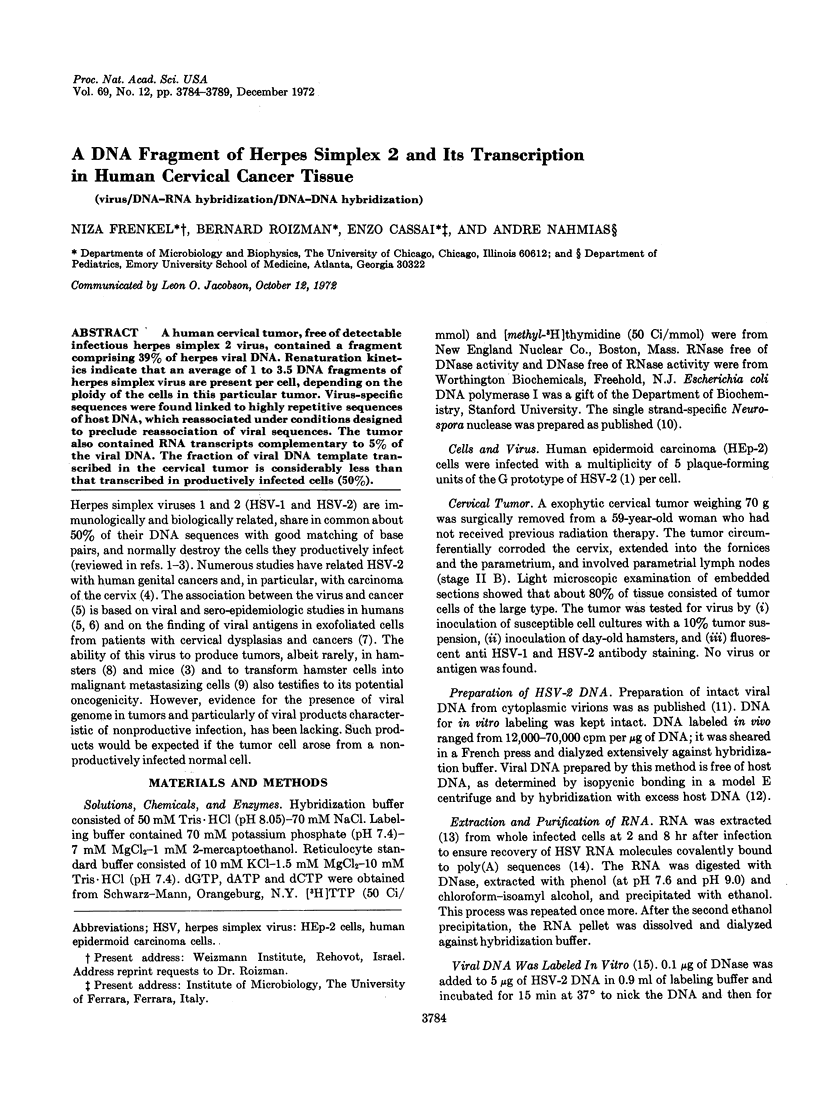Abstract
A human cervical tumor, free of detectable infectious herpes simplex 2 virus, contained a fragment comprising 39% of herpes viral DNA. Renaturation kinetics indicate that an average of 1 to 3.5 DNA fragments of herpes simplex virus are present per cell, depending on the ploidy of the cells in this particular tumor. Virus-specific sequences were found linked to highly repetitive sequences of host DNA, which reassociated under conditions designed to preclude reassociation of viral sequences. The tumor also contained RNA transcripts complementary to 5% of the viral DNA. The fraction of viral DNA template transcribed in the cervical tumor is considerably less than that transcribed in productively infected cells (50%).
Keywords: virus, DNA-RNA hybridization, DNA-DNA hybridization
Full text
PDF





Selected References
These references are in PubMed. This may not be the complete list of references from this article.
- Duff R., Rapp F. Properties of hamster embryo fibroblasts transformed in vitro after exposure to ultraviolet-irradiated herpes simplex virus type 2. J Virol. 1971 Oct;8(4):469–477. doi: 10.1128/jvi.8.4.469-477.1971. [DOI] [PMC free article] [PubMed] [Google Scholar]
- Frenkel N., Roizman B. Herpes vimplex virus: genome size and redundancy studied by renaturation kinetics. J Virol. 1971 Oct;8(4):591–593. doi: 10.1128/jvi.8.4.591-593.1971. [DOI] [PMC free article] [PubMed] [Google Scholar]
- Frenkel N., Roizman B. Ribonucleic acid synthesis in cells infected with herpes simplex virus: controls of transcription and of RNA abundance. Proc Natl Acad Sci U S A. 1972 Sep;69(9):2654–2658. doi: 10.1073/pnas.69.9.2654. [DOI] [PMC free article] [PubMed] [Google Scholar]
- Kieff E. D., Bachenheimer S. L., Roizman B. Size, composition, and structure of the deoxyribonucleic acid of herpes simplex virus subtypes 1 and 2. J Virol. 1971 Aug;8(2):125–132. doi: 10.1128/jvi.8.2.125-132.1971. [DOI] [PMC free article] [PubMed] [Google Scholar]
- Kieff E., Hoyer B., Bachenheimer S., Roizman B. Genetic relatedness of type 1 and type 2 herpes simplex viruses. J Virol. 1972 May;9(5):738–745. doi: 10.1128/jvi.9.5.738-745.1972. [DOI] [PMC free article] [PubMed] [Google Scholar]
- LEUCHTENBERGER C., LEUCHTENBERGER R., DAVIS A. M. A microspectrophotometric study of the desoxyribose nucleic acid (DNA) content in cells of normal and malignant human tissues. Am J Pathol. 1954 Jan-Feb;30(1):65–85. [PMC free article] [PubMed] [Google Scholar]
- LIN H. J., CHARGAFF E. METAPHASE CHROMOSOMES AS A SOURCE OF DNA. Biochim Biophys Acta. 1964 Dec 16;91:691–694. doi: 10.1016/0926-6550(64)90032-5. [DOI] [PubMed] [Google Scholar]
- Lee S. Y., Mendecki J., Brawerman G. A polynucleotide segment rich in adenylic acid in the rapidly-labeled polyribosomal RNA component of mouse sarcoma 180 ascites cells. Proc Natl Acad Sci U S A. 1971 Jun;68(6):1331–1335. doi: 10.1073/pnas.68.6.1331. [DOI] [PMC free article] [PubMed] [Google Scholar]
- Nahmias A. J., Naib Z. M., Josey W. E., Murphy F. A., Luce C. F. Sarcomas after inoculation of newborn hamsters with Herpes virus hominis type 2 strains. Proc Soc Exp Biol Med. 1970 Sep;134(4):1065–1069. doi: 10.3181/00379727-134-34945. [DOI] [PubMed] [Google Scholar]
- Naib Z. M., Nahmias A. J., Josey W. E. Cytology and histopathology of cervical herpes simplex infection. Cancer. 1966 Jul;19(7):1026–1031. doi: 10.1002/1097-0142(196607)19:7<1026::aid-cncr2820190718>3.0.co;2-#. [DOI] [PubMed] [Google Scholar]
- Rabin E. Z., Preiss B., Fraser M. J. A nuclease from Neurospora crassa conidia specific for single-stranded nucleic acids. Prep Biochem. 1971;1(4):283–307. doi: 10.1080/00327487108081946. [DOI] [PubMed] [Google Scholar]
- Rawls W. E., Tompkins W. A., Melnick J. L. The association of herpesvirus type 2 and carcinoma of the uterine cervix. Am J Epidemiol. 1969 May;89(5):547–554. doi: 10.1093/oxfordjournals.aje.a120967. [DOI] [PubMed] [Google Scholar]
- Royston I., Aurelian L. Immunofluorescent detection of herpesvirus antigens in exfoliated cells from human cervical carcinoma. Proc Natl Acad Sci U S A. 1970 Sep;67(1):204–212. doi: 10.1073/pnas.67.1.204. [DOI] [PMC free article] [PubMed] [Google Scholar]
- Saunders G. F., Shirakawa S., Saunders P. P., Arrighi F. E., Hsu T. C. Populations of repeated DNA sequences in the human genome. J Mol Biol. 1972 Feb 14;63(3):323–334. doi: 10.1016/0022-2836(72)90430-5. [DOI] [PubMed] [Google Scholar]
- Spear P. G., Roizman B. Proteins specified by herpes simplex virus. V. Purification and structural proteins of the herpesvirion. J Virol. 1972 Jan;9(1):143–159. doi: 10.1128/jvi.9.1.143-159.1972. [DOI] [PMC free article] [PubMed] [Google Scholar]
- Wetmur J. G., Davidson N. Kinetics of renaturation of DNA. J Mol Biol. 1968 Feb 14;31(3):349–370. doi: 10.1016/0022-2836(68)90414-2. [DOI] [PubMed] [Google Scholar]


